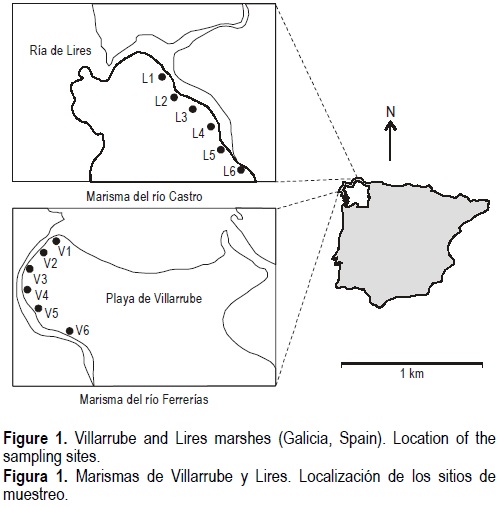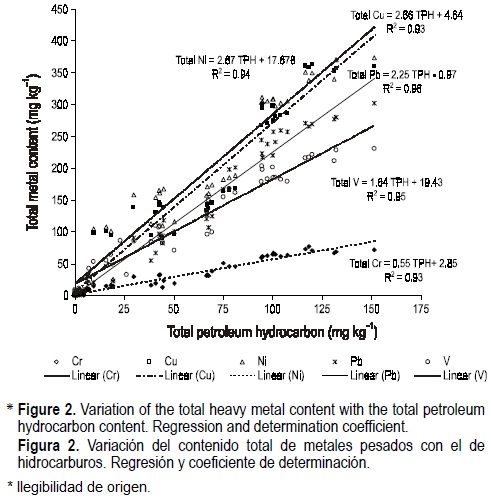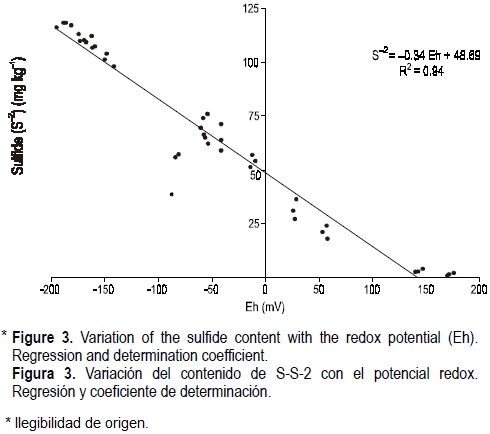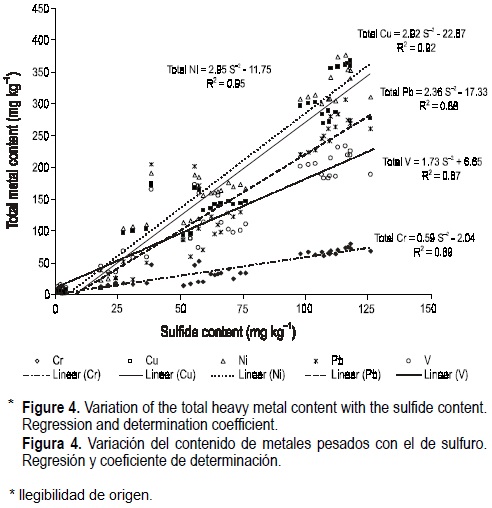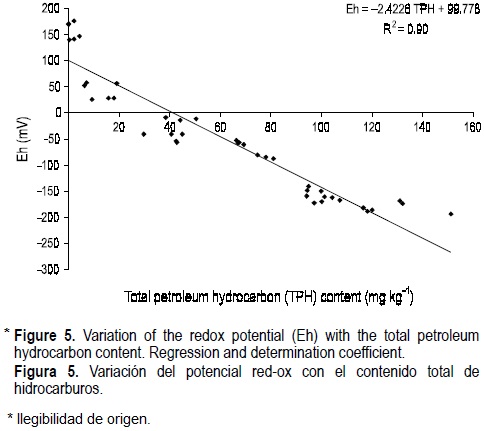Services on Demand
Journal
Article
Indicators
-
 Cited by SciELO
Cited by SciELO -
 Access statistics
Access statistics
Related links
-
 Similars in
SciELO
Similars in
SciELO
Share
Ciencias marinas
Print version ISSN 0185-3880
Cienc. mar vol.30 n.3 Ensenada Sep. 2004
Artículos
Impact of the Prestige oil spill on marsh soils: Relationship between heavy metal, sulfide and total petroleum hydrocarbon contents at the Villarrube and Lires marshes (Galicia, Spain)
Impacto de la marea negra del Prestige en suelos de marisma: relación entre los contenidos de metales pesados, sulfuros e hidrocarburos en las marismas de Villarrube y Lires (Galicia, España)
L. Andrade1*, P. Marcet1, L. Fernández-Feal2, C. Fernández-Feal2, E.F. Covelo1 and F.A. Vega1
1 Department of Vegetable Biology and Soil Science Apartado 874 36200 Vigo, Spain. * E-mail: mandrade@uvigo.es
2 Escuela Politécnica Superior Universidad de la Coruña Campus Ferrol, Mendizábal s/n Ferrol, Spain.
Recibido en junio de 2003;
aceptado en marzo de 2004.
Abstract
The objectives of this study were to determine the effect of the Prestige oil spill on the total petroleum hydrocarbons and heavy metal contents of soils in two marshes (Lires and Villarrube, Galicia, Spain) and the relationship between their oxidation-reduction potential and the solubility of heavy metals with sulfide and sulfate contents. Soil samples were taken from polluted and unpolluted areas and their petroleum hydrocarbon contents, heavy metal contents and other chemical characteristics were measured. The soils affected by the oil spill show remarkable contents of Cr, Cu, Ni, Pb and V. The Lires marsh soils are more affected by fuel oil than Villarrube marsh. The effects of the contaminating agents on the soils reach distances of up to 500 m from the coastline. In the first 400 m, there are important spatial variations because the fuel oil penetrated into the soils through tidal action and not directly. The Cr, Cu, Ni, Pb and V contents of polluted soils were between 50 and 200 times higher than those of their unpolluted counterparts and the background concentrations in Galician coastal sediments. In the case of Cr, Cu, Ni, Pb and V, their originthrough the fuel oil was corroborated by the high correlation (r > 0.90) between the concentrations of these metals and the total petroleum hydrocarbon content of the polluted soils, which shows the combined addition of these metals through the fuel oil.
Key words: heavy metals, hydrocarbons, oil spill, marsh soils.
Resumen
Los objetivos de este trabajo fueron determinar el efecto de la marea negra del buque tanque Prestige en el contenido total de hidrocarburos y de metales pesados en suelos de dos marismas (Lires y Villarrube, Galicia, España) y la relación entre el potencial de oxidación-reducción y la solubilidad de los metales pesados con los contenidos de sulfuros y de sulfatos. Se tomaron muestras de suelos de las zonas contaminadas y no contaminadas y se determinaron diversas características químicas, el contenido total de hidrocarburos y de metales pesados. Los suelos afectados por la marea negra muestran contenidos destacables de Cr, Cu, Ni, Pb y V. Los suelos de la marisma de Lires están más afectados que los de la de Villarrube. Los efectos de los agentes contaminantes sobre los suelos llegan hasta distancias de 500 m de la línea de costa. En los primeros 400 metros existen importantes variaciones espaciales debidas a que el fuel penetró en el suelo a través de las oscilaciones mareales y no directamente. Las cantidades de Cr, Cu, Ni, Pb y V en los suelos contaminados son de entre 50 y 200 veces mayores que las de los no contaminados y que los niveles de fondo de los sedimentos costeros de Galicia. La estrecha correlación positiva establecida entre los contenidos de metales pesados en los suelos y entre el contenido total de hidrocarburos y el de metales pesados (r > 0.9) muestra el aporte conjunto de los metales a través del fuel.
Palabras clave: metales pesados, hidrocarburos, marea negra, marismas, suelos.
Introduction
Marshes are an important part of fluvial, estuarial and coastal ecosystems. The short-term effects of fuel oil on marshes depends primarily on the vegetative responses. The adverse effects of oil on plants range from reductions in transpiration and carbon fixation to plant mortality (Pezeshki et al., 2000), and the long-term effects depend more on the response of the soil microbial community that controls the remineralization of nutrients, soil redox potential and fuel oil degradation (Nyman and Patrick, 1995). The response of the soil microbial community may be influenced by the content of heavy metals in the marsh soils.
The Villarrube (4°23'40" W, 43°38'10" N) and Lires (9°15'06" W, 43°00'08" N) marshes are located in northwestern Galicia (Spain), in the estuaries of the rivers Ferrerías (Cedeira Ría) and Castro (Lires Ría), respectively. Both marshes were considered ecosystems that had not been negatively affected by human action (Fernández-Feal, 1999; Marcet et al., 2000).
Low bulk densities, high organic matter content and high sulfide content often characterize tidal marsh soils (Griffin and Rabenhorst, 1989; Fernández-Feal, 1999; Marcet et al., 2000; Andrade et al., 2002). The organic matter accumulated by superficial deposition of marsh grass detritus and urban effluents is very important to the fate of trace metals (Griffin and Rabenhorst, 1989). The oxidation status of soils and sediments affects the distribution of some trace metals among bound, unavailable, soluble and available forms (Gambrell et al., 1991).
The combination of anaerobic conditions and high organic matter content makes the salt marsh environment ideal for bacterial reduction of sulfates to sulfides (Pons and Van Breemen, 1982). This process plays an important role in the development of marsh sediments and in the control of heavy metal solubility.
This paper reports the effects of the Prestige oil spill on the hydrocarbon and heavy metal contents of the soils of two affected estuarine environments two weeks after the spill had occurred.
Material and methods
One sample of emulsified fuel oil was taken from the sea and another two from each marsh. The fuel oil characterization and analytical methods are described briefly in table 1.
The soil sampling sites extended 750 m from the coastline during low tide (fig. 1). Six soil samples (Thionic Fluvisol) were taken during low tide at each marsh (samples V and L) two weeks after the spillage and immediately after cleaning the beaches, one sample every 100 m and two controls (at 750 m, control L and control V). The sampling sites were chosen to obtain a representative measure of the pollution conditions in the marshes.
Topsoil (0-30 cm) samples were collected using an Eijkelkamp sampler and the samples were stored in polyethylene bags in darkness at 4°C. Five samples of each site were taken at each sampling point. The samples from each site were air-dried, passed through a 2-mm sieve, mixed and homogenized in the laboratory. Subsequently, five subsamples from each aggregate sample were taken.
Redox potential (Eh) was measured on site, using a platinum electrode and a calomel reference electrode. Both electrodes were introduced into the topsoil to a depth of 1520 cm. Ten measurements were made at each sampling site, and the results are the average of all of them. The Eh was measured based on a standard hydrogen reference electrode.
Sulfide was determined starting from the difference between the iron extracted with hydrochloric acid and nitric acid (Tabatabai, 1982), and the adsorbed S-SO4-2 was extracted with a solution containing LiCl2 0.1M and P (500 mg L-1) (Tabatabai, 1982). Both were analyzed by turbidimetry with barium acetate.
The available content of Cr, Cu, Ni, Pb and V was extracted by the DTPA method developed by Lindsay and Norwell (1978). Total contents were extracted by acid digestion using a mixture of concentrated nitric, hydrochloric and hydrofluoric acids (1:3:3 v/v) in Teflon reactors placed in a microwave oven (Marcet et al., 1997).
The analysis of Cr, Cu, Ni, Pb and V was carried out by ICP-OES (Perkin-Elmer Optima 4300 DV).
The efficiency of the extraction and analysis procedures was controlled by analyzing international standard reference material of marine sediment from estuaries such as MESS-3 (10 repetitions for each element) from the Marine Analytical Chemistry Standards Program of the Canadian National Research Council (Ottawa, Canada); the procedure is described in Marcet et al. (1997). MESS-3 is estuarial sediment characterized by a low average metal concentration, making the sediments an appropriate tool for the analytical control of the samples from the Galician marshes. The confidence intervals of the values obtained were similar to those certified by the Canadian National Research Council (table 2).
Total petroleum hydrocarbon content (TPH) was determined by the ISO/TR 11046 (E) (1994) procedure, proposed by RIZA (1980, 1987), Pennings (1987) and Weisman (1998). The soil samples, obtained in the field and stored in darkness at 4°C, were chemically dried with a hygroscopic salt, crushed and then extracted with 1,1,2-trichloro-1,2,2-trifluoroethane, adding magnesium silicate and shaking to remove the polar compounds. For quantitative determination, the extract was added to hexane and analyzed by gas chromatography. For detection, a flame ionization detector was used. The total petroleum hydrocarbon content of the samples was calculated using an external standard prepared with a mixture of n-alkane standard with carbon numbers between C6 and C36 (Weisman, 1998).
The data were statistically analyzed and the least significant differences (LSD), at 5% level, used to separate means. The relationship between the different variables was evaluated by a simple correlation and regression analysis (Neter et al., 1996).
Results and discussion
The heavy metal contents in the soils of both marshes are higher that the normal levels from petrogenic origin in these zones (tables 3, 4) (Marcet et al., 1997; Fernández-Feal, 1999; Carballeira et al., 2000; Marcet et al., 2000), which seems to indicate the effect of the oil spill on these soils.
Polluted soils had significantly higher values than control soils (P < 0.05) with respect to total Cr, Cu, Ni, Pb and V contents. The heavy metal concentrations found in the polluted soils also exceeded the average concentrations in unpolluted Galician coastal sediments and soils (Barreiro et al., 1988, 1994; Marcet et al., 1997; Fernández-Feal, 1999; Carballeira et al., 2000; Marcet et al., 2000) and the background levels (table 3) (Barreiro et al., 1988, 1994; Carballeira et al., 2000). The highest levels were found at Lires marsh, yielding evidence in the sense that this marsh was more affected by the fuel than the Villarube one.
The combined addition of these metals through the fuel oil seems to be corroborated by the significant positive correlation between the total heavy metal content with TPH content (r > 0.90, P < 0.01) in all cases (fig. 2), and also significant mutual correlation (r > 0.90, P < 0.01) (table 5) among total Cr, Cu, Ni, Pb and V levels (table 5).
DPTA-extractable metal contents were likewise low in relative terms (table 4). The predominance of insoluble forms is attributable to the low Eh values of these soils, and hence partly, in the case of the polluted soils, to their TPH contents (table 4).
The differences in heavy metal content in the soils are not related to their nature and properties (grain-size, organic matter content).
The relationship established between the oxidation-reduction potential and the sulfide content, and between the latter and the total contents of Cr, Cu, Ni, Pb and V (figs. 3, 4) shows that when there is a larger reduction the metal contents increase because they remain in the soil as precipitated sulfides. A significant negative relationship between the oxidation-reduction potential and the total content of hydrocarbons has also been established (fig. 5, r = -0.9, and significant for P < 0.01), which probably indicates that the fuel oil causes anaerobiosis and prevents the sulfide oxidation to sulfate and the heavy metals mobilization.
So, the redox potential has a decisive effect on the amount of Cr, Cu, Ni, Pb and V in insoluble form. Table 4 shows that the highest concentrations occur under reduced conditions, gradually decreasing when they change to oxidant values. Gambrell et al. (1991) found that soluble heavy metals were hardly affected by the oxidation-reduction potential except at intermediate oxidation-reduction potentials similar to those found in the soils studied in this paper.
However, the scarce amount of S-SO4-2 and metals in available form (table 4) shows that when oxidation is produced by the fluctuation of the tide, or desiccation, a great proportion of these metals will become easily soluble forms, which can affect waters, fauna and flora, risking their entry into the trophic chain.
The effect of the fuel oil spill on polluted marsh soils was displayed by the Eh values and the low concentrations of Cr, Cu, Ni, Pb and V in available form, against high total contents, precipitated as sulfides.
The effects of the contaminant substances on the soils begin to weaken 500 m from the coastline. In spite of the correlation established between the distance to the coastline and heavy metal and total petroleum hydrocarbon content (table 5), in the first 400 m, there are important spatial variations because the metals and hydrocarbons penetrate into the soils through tidal action and not directly.
Finally, it must be noted that at several points in both marshes, there are very high total amounts of Cr, Cu, Ni, Pb, V and hydrocarbons (table 3). This may seriously jeopardize the fauna and flora if the acidic conditions allow part of these contents to become soluble. It must be highlighted that according to data provided by Andrade et al. (2002), the heavy metal content in the contaminated soils is about 50 to 200 times greater than the content in uncontaminated soils (control). This, in the near future, will have repercussions on the available amounts of heavy metal content and consequently the environmental quality of these areas.
References
Andrade, M.L., Reyzabal, M.L., Marcet, P. and Montero, M.J. (2002). Industrial impact on marsh ecosystem at the Bahía Blanca Ría (Argentina). J. Environ. Qual., 31: 532-538. [ Links ]
ASTM D 1998 and 482 (1995). In: Annual Book of ASTM Standards. Section 5. Petroleum Products, Lubricants, and Fossil Fuels, 05.01. Petroleum Products and Lubricants (I). ASTM, Philadelphia, 994 pp. [ Links ]
ASTM D 4239 C (1995). In: Annual Book of ASTM Standards. Section 5. Petroleum Products, Lubricants, and Fossil Fuels, 05.02. Petroleum Products and Lubricants (II). ASTM, Philadelphia, 1016 pp. [ Links ]
ASTM D 3605 (1995). In: Annual Book of ASTM Standards. Section 5. Petroleum Products, Lubricants, and Fossil Fuels, 05.03. Petroleum Products and Lubricants (III). ASTM, Philadelphia, 1046 pp. [ Links ]
Barreiro, R., Carballeira, A. and Real, C. (1988). Metales pesados en los sedimentos de cinco sistemas de ría (Ferrol, Burgo, Arousa, Pontevedra y Vigo). Thalassas, 6: 61-70. [ Links ]
Barreiro, R., Real, C. and Carballeira, A. (1994). Heavy metals in sediment cores from NW-Spain estuary. Bull. Environ. Contam. Toxicol., 53: 368-373. [ Links ]
Carballeira, A., Carral, E., Puente, X. and Villares, R. (2000). Regional-scale monitoring of coastal contamination. Nutrients and heavy metal in estuarine sediments and organisms on the coast of Galicia (northwest Spain). Int. J. Environ. Pollut., 13(1-6): 534-572. [ Links ]
Fernández-Feal, M.L. (1999). Contribución al estudio de las marismas de los ríos Xubia y Ferrerías. Tesis doctoral, Universidad de La Coruña, España, 349 pp. [ Links ]
Gambrell, R.P., Wiesepape, J.B., Patrick, W.H. and Duff, M.C. (1991). The effects of pH, redox and salinity on metal release from a contaminated sediment. Water, Air, Soil Pollut., 57, 58: 35-367. [ Links ]
Griffin, T.M. and Rabenhorst, M.C. (1989). Process and rates of pedogenesis in some Maryland tidal marsh soils. Soil Sci. Soc. Am. J., 53: 862-870. [ Links ]
ISO/TR 11046(E) (1994). ISO Standard Compendium. Environmental Soil Quality. General Aspects. Chemical and Physical Methods of Analysis, Biological Methods of Analysis. ISO Geneva, Switzerland: 105-111. [ Links ]
Lindsay, W.L. and Norwell, W.A. (1978). Development of a DTPA soil test for zinc, iron, manganese and copper. Soil Sci. Soc. Am. J., 42: 421-428. [ Links ]
Marcet, P., Andrade, M.L. and Montero, M.J. (1997). Efficacité d'une methode de digestion par microondes pour la determination de Fe, Mn, Zn, Cu, Pb Cr Al et Cd en sédiments. In: R. Prost (ed.), Contaminated Soils. Third Int. Conf. on the Biogeochemistry of trace-elements. Data\communic\055.PDF, Colloque No. 85, INRA Editions, Paris, France, pp. 1-8. [ Links ]
Marcet, P., Fernández-Feal, M.L., Andrade-Couce, M.L. y Montero-Vilariño, M.J. (2000). Efecto de la influencia antrópica sobre las características fisicoquímicas de dos suelos de marisma. Edafología, 7(3): 11-19. [ Links ]
Neter, J., Kutner, M.H., Nachteim, C.J. and Wasserman, W. (1996). Applied linear Statistcal Models, 4th Edition, MacGraw-Hill Professional Publishing. Irwin, Chicago, IL, USA, 1408 pp. [ Links ]
Nyman, J.A. and Patrick, W.H. (1995). Effects of oil and chemical responses on fresh marsh function and oil degradation: Response implications. Tech. Rep. Ser., 95-011: 37 pp. [ Links ]
Pennings, M. (1987). The influence of column choice and method of integration when determining mineral oil gas chromato-graphically. ICW Note 1824. Winand Staring Centre, Wageningen. [ Links ]
Pezeshki, S.R., Hester, M.W., Lin, Q. and Nyman. J.A. (2000). The effects of oil spill and clean up on dominant US Gulf coast marsh macrophytes: A review. Environ. Pollut., 108: 129-139. [ Links ]
Pons, L.J. and Van Breemen, N. (1982). Factors influencing the formation of potential acidity in tidal swamps. In: H. Dost and Van Breemen (eds.), Proc. Bangkok Symp. on Acid Sulphate Soils. ILRI. The Netherlands, pp. 35-37. [ Links ]
RIZA (1980). Quantification of the mineral oil content in extracts from environmental samples: Comparison of various standardized methods. RIZA note 88.040x. Lelystad. [ Links ]
RIZA (1987). Quantitative determination of mineral oil in watersoil, RIZA note 87.062x. Lelystad. [ Links ]
Tabatabai, M.A. (1982). Analytical methods for sulphur. Proc. Conference International Sulfur, 82: 1. [ Links ]
Weisman, W.H. (ed.) (1998). Total Petroleum Hydrocarbon Criteria Working Group Series. Vol. 1. Analysis of Petroleum Hydrocarbons in Environmental Media. Amherst Scientific Publ., Amherst, Massachusetts, 98 pp. [ Links ]













